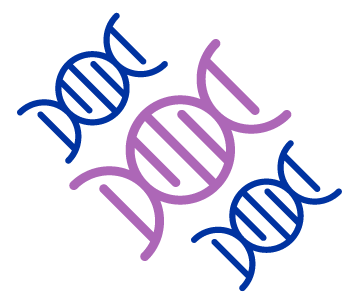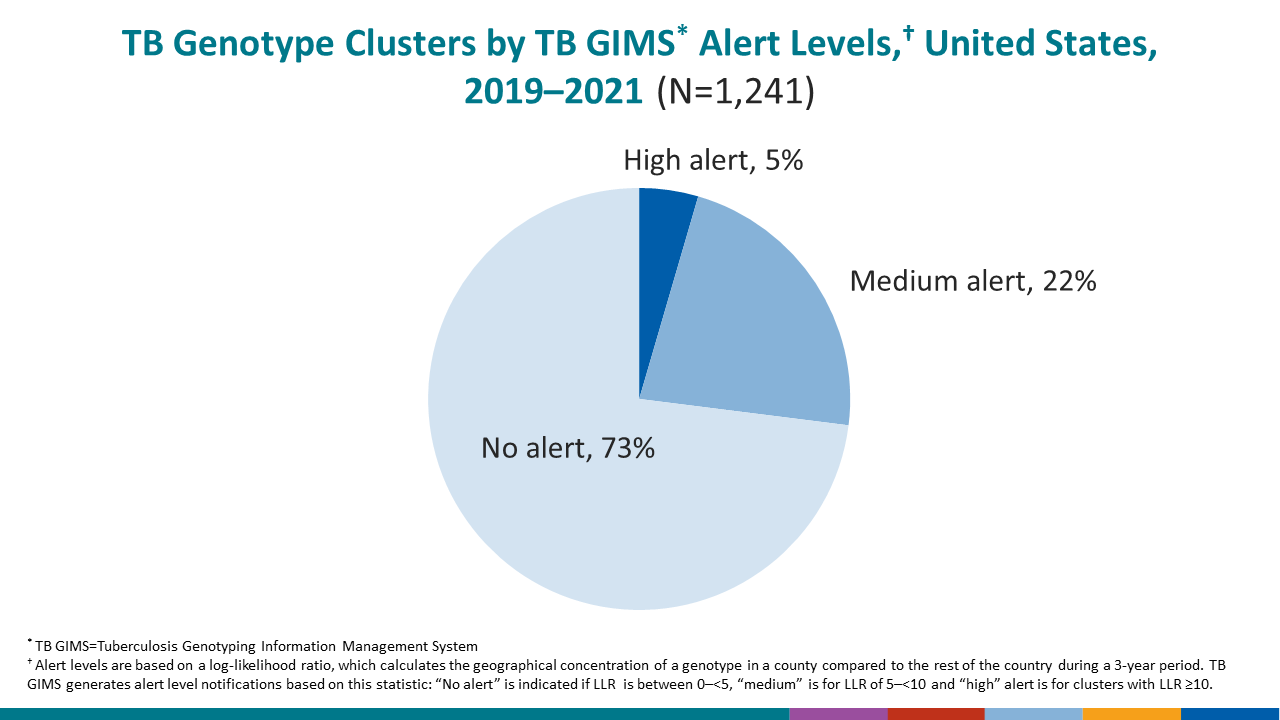Reported Tuberculosis in the United States, 2021
Genotype Clusters

TB genotyping is a laboratory-based approach used to analyze genetic material (e.g., DNA) of Mycobacterium tuberculosis; characterizing distinct genetic patterns facilitates distinguishing certain M. tuberculosis strains from others. Clusters of TB cases with matching genotypes are an indication of possible recent TB transmission.
In this report, a TB case is considered clustered if the isolate genotype matched one or more other cases in the same county or county-equivalent area during the 3-year period of 2019–2021. CDC generates cluster alerts (i.e., medium alert and high alert) based on the degree of geospatial concentration of cases with matching genotypes within the same county or county-equivalent area compared with the concentration of the genotype outside of the given county or county-equivalent. CDC reviews medium and high alerts weekly for possible programmatic follow-up.
The number of reported TB cases with a genotype increased from 5,586 in 2020 to 6,075 in 2021, an 8.8% increase mirroring the national case count increase. Since 2015, over 97% of culture-positive cases in the United States have been genotyped annually (TB Genotyping Surveillance Coverage: 2004–2021).
During 2019–2021, 19.2% of TB cases were clustered. Cases occurring in certain demographic groups continue to be overrepresented in genotype matched clusters and alerted clusters.
- Among cases occurring in U.S.-born persons, 34.6% were clustered compared with 13.5% of cases occurring in non-U.S.–born persons.
- Among all cases associated with a cluster during 2019–2021, cases occurring in Hispanic or Latino persons (n=1,277), non-Hispanic Black or African American persons (n=880), and non-Hispanic Asian persons (n=810) represented the highest number of clustered cases.
- During 2019–2021, 54.3% of cases occurring in American Indian or Alaska Native persons and 52.5% of Native Hawaiian or Other Pacific Islander persons were clustered. (Characteristics of TB Cases in GENType Clusters by Alert Levels: 2019–2021).
The number of county-based clusters declined from 1,280 in last year’s report (cases reported nationally during 2018–2020) to 1,241 clusters for 2019–2021, a 3.0% reduction.
CDC identifies genotype-matched clusters, which can represent TB outbreaks, using geospatial analysis to identify unexpected clustering of TB cases within a defined time period. TB control programs can use this cluster detection information to help allocate and prioritize resources for investigation and intervention for specific cases that might be caused by recent transmission.
CDC’s primary outbreak detection method is based on identifying higher than expected geospatial concentrations of a TB genotype in a specific county, compared with the national distribution of that genotype. Genotype clusters are characterized into an alert level of non-alert, medium alert, or high alert based on a log-likelihood ratio calculation.
- During 2019–2021, 38.3% of clustered cases were included in clusters that were classified as either medium or high alert, which are reviewed for possible programmatic follow-up.
- Among cases occurring in U.S.-born persons, 54.7% of clustered cases were in medium or high alert clusters compared with 22.9% of cases occurring in non-U.S.–born persons.
Source: Characteristics of TB Cases in GENType Clusters by Alert Levels: 2019–2021
Learn more in the Executive Commentary.
- TB Genotyping Surveillance Coverage: 2004–2021
- TB Genotyping Surveillance Coverage: U.S.-Affiliated Reporting Areas, 2004–2021
- Mycobacterium bovis by Origin of Birth: 2004–2021
- Characteristics of TB Cases in GENType Clusters by Alert Levels: 2019–2021
- TB Clusters by Size: 2019–2021
- Most Frequently Reported GENTypes: 2019–2021
- Most Frequently Reported GENTypes: U.S.-Affiliated Reporting Areas, 2019–2021
- TB Genotyping Surveillance Coverage: Reporting Areas, 2021
